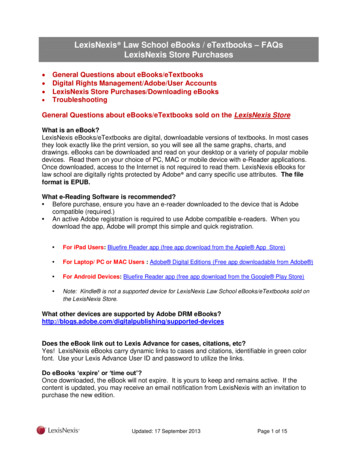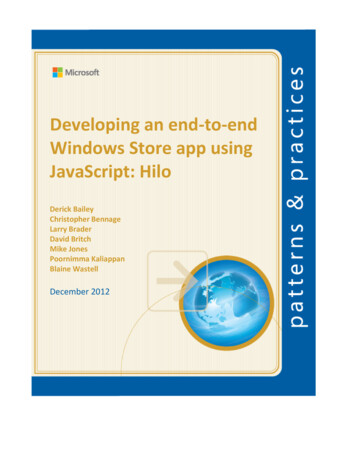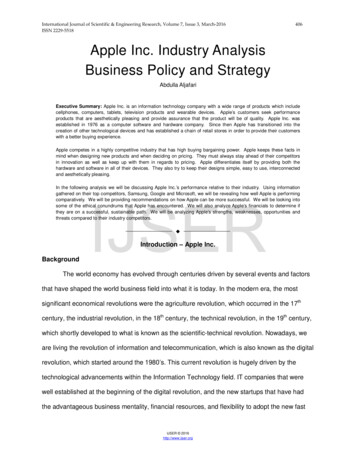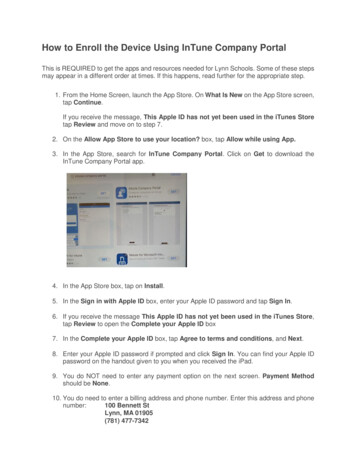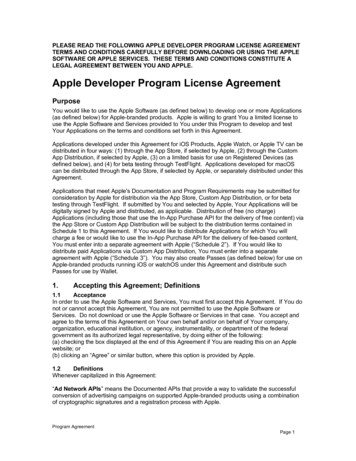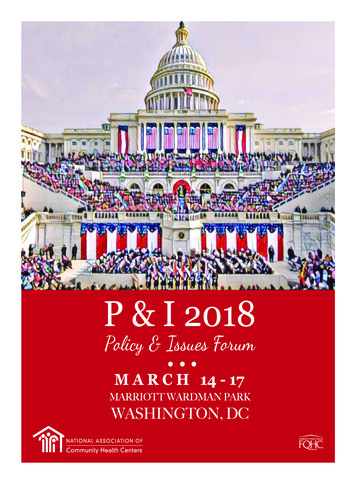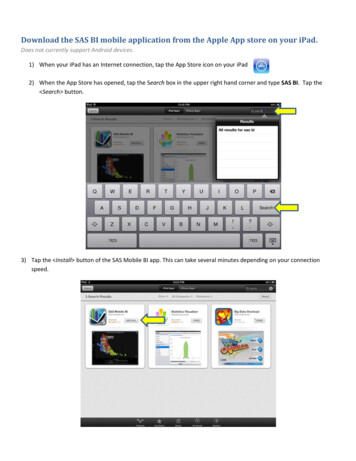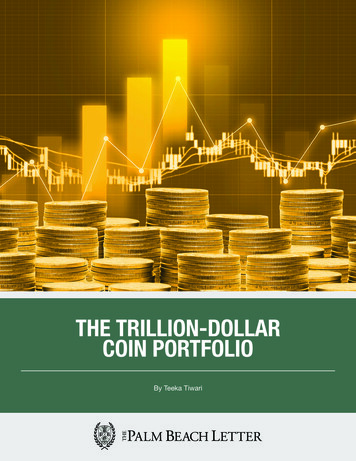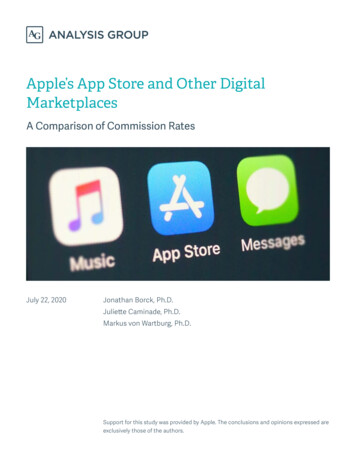
Transcription
Apple’s App Store and Other DigitalMarketplacesA Comparison of Commission RatesJuly 22, 2020Jonathan Borck, Ph.D.Juliette Caminade, Ph.D.Markus von Wartburg, Ph.D.Support for this study was provided by Apple. The conclusions and opinions expressed areexclusively those of the authors.
Apple’s App Store and Other Digital MarketplacesOver the last two decades, with advances in digital and mobile technologies, digitalmarketplaces have emerged as a new type of business model. Digital marketplaces areplatforms that use digital technologies and tools to connect buyers and sellers. They havebecome ubiquitous in many sectors of the economy: examples include retail marketplacessuch as Amazon and Etsy, ridesharing apps such as Uber and Lyft, travel platforms such asAirbnb and Booking.com, and food delivery platforms such as Grubhub and Uber Eats.Digital marketplaces create value by facilitating and promoting valuable transactionsbetween buyers and sellers. As a result, they typically share certain features that arecritical to their management and success. Many digital marketplaces, for example, setup rules and policies to govern transactions and promote trust and reliability amongboth sellers and buyers. Some digital marketplaces also provide various services to usersand invest in technology to improve the performance of the platform. In return, digitalmarketplaces typically charge fees based on the transactions they facilitate.Apple’s App Store ecosystem facilitates interactions between app developers andnearly one billion Apple device owners globally. To promote its success, Apple providesdevelopers with distribution, search, and review services, as well as a set of tools to buildand monetize apps. Apple also invests in the safety of the App Store and in developingnew technologies and functionalities. While Apple charges developers an annual fee toenroll in its Developer Program and upload apps to the App Store, Apple does not chargedevelopers to offer each individual app on the App Store, to distribute updates to users,or to access Apple’s app analytics, marketing, and developer tools. Apple receives acommission from developers when users download paid apps and make in-app purchasesof digital content, services, and subscriptions.1,2Study GoalThe goal of this study is to compare the commission rates of Apple’s App Store with thoseof other app stores and digital marketplaces, and to evaluate the App Store commissionand associated rules in the context of the business model used both by digitalmarketplaces and platforms in general.Apple’s App Store commission rate is similar in magnitude tothose of other app stores and digital content marketplaces.1Apple does not charge a commission on the purchase of physical products and services through the app.2 Developers set the price of apps on the App Store, and Apple does not charge consumers anything (beyond theprice set by the developer) to obtain apps or digital content.ANALYSIS GROUP 1
Apple’s App Store and Other Digital MarketplacesFindingsOur study shows that Apple’s App Store commission rate is similar in magnitude to thecommission rates charged by many other app stores and digital content marketplaces.The commission rates charged by digital marketplaces most similar to the App Store, suchas other app stores and video game digital marketplaces, are generally around 30%.Marketplaces that distribute digital content such as videos, podcasts, eBooks, andaudiobooks generally charge commission rates of 30% or more. Commission rates chargedby e-commerce marketplaces vary by industry but sometimes exceed 30%.Many sellers currently sell (or previously sold) their goods through brick-and-mortar storesand marketplaces. We find that sellers generally earn a substantially lower share of totalrevenue from the distribution through brick-and-mortar stores and marketplaces thanthrough digital marketplaces such as the Apple App Store.Developers earn a substantially higher share of total salesmade through digital marketplaces, including the Apple AppStore, than through many brick-and-mortar channels.Digital Marketplaces and Their Business ModelsDigital marketplaces are relatively novel platforms. Some have disrupted entire industriessuch as hospitality, food delivery, or ridesharing. Some have expanded existing markets,while others created entirely new markets. All rely on improved technologies such assmartphones and video game consoles. Irrespective of their particular context, digitalplatforms share a set of characteristics and way of operating. Digital marketplaces are two-sided platforms that connect sellers and buyers andprovide them with an environment in which to interact and trade. For example,travelers and hosts can connect and transact through the Airbnb platform.Passengers and drivers can connect through the Uber and Lyft apps. And app storesconnect app developers with device owners who are interested in those apps. A marketplace’s attractiveness is determined primarily by its ability to bring onboard enough buyers and enough sellers, in a way that preserves the platform’s trustand integrity. By enrolling more high-quality sellers, a digital marketplace becomesmore valuable to buyers. Similarly, by engaging more buyers, a digital marketplacebecomes more valuable to sellers. This feature of digital marketplaces is known asan “indirect network effect.” Digital marketplaces provide tools and services to facilitate and encouragevaluable interactions between buyers and sellers, or between developers andusers. This involves upfront investments to build the platform, as well as continuedANALYSIS GROUP 2
Apple’s App Store and Other Digital Marketplacesinvestments to enhance the platform with improved functionalities to maintain itsappeal to all users of the platform. Such functionalities include helping users findproducts that match their interests and pay in secure ways. Digital marketplaces may provide more than matchmaking. Some invest in varioustools and technologies to help sellers and developers offer innovative products andbetter ways to monetize them.Apple’s App Store exhibits features of a digital marketplace: Connecting developers and app users – The App Store is a digital marketplace forapp developers and Apple device users to interact and transact. The App Storeenables developers of all sizes to distribute apps (and updates) to a large andvaluable base of users throughout the world.3 Users can download a variety of appsfrom many different developers. Attracting developers and engaging app users – Users have access to a diverselibrary of almost two million apps that have gone through Apple’s app reviewprocess. All apps submitted to the App Store must abide by the App Store ReviewGuidelines, which set out standards for safety, performance, business, and design,as well as legal requirements.4 The goal of this review process is to ensure that allapps on the App Store are safe, thereby preserving the trust and integrity of theecosystem. Providing tools to encourage valuable interactions between developers andusers – Apple offers tools — including secure payment services, app analytics, andreporting tools — to assist developers in their marketing and sales efforts. Applealso continues to develop additional search functionalities and refine its searchalgorithm to help users find apps. Investing in the ecosystem – Apple invests in its ecosystem to attract andincentivize developers to create and sell innovative apps. One way it does so isby providing developers with tools, compilers, programming languages, libraries,application programming interfaces (APIs), and software development kits (SDKs)to create, test, configure, and upgrade their apps. In addition, Apple makes itsinnovations and intellectual property available to developers, for example, throughthe use of custom chips, cameras, operating system and security features, andcloud services.Because the value of digital marketplaces comes from enabling and facilitatingtransactions and making investments to support these transactions, digital marketplacestypically charge transaction fees. Transaction-based commission rates lower the barriers3 The user base of the Apple App Store tends to be more affluent and has a greater propensity to spend on apps.See Omdia, App Ecosystems Forecast 2019–2024.4 See Apple’s App Store Review Guidelines elines) and KifLeswing, “Inside Apple’s team that greenlights iPhone apps for the App Store,” CNBC (June 21, 2019).ANALYSIS GROUP 3
Apple’s App Store and Other Digital Marketplacesto entry for small sellers and developers by minimizing upfront payments, and reinforcethe marketplace’s incentive to promote matches that generate high long-term value.Comparison of the Commission Rates of Apple’s App Store with Those ofOther App Stores and MarketplacesThe Apple App Store’s commission ratesApple charges a commission when device owners download paid apps and make in-apppurchases of digital content, services, and subscriptions.5 Developers earn 70% of salesfrom paid apps and in-app purchases, and Apple collects a 30% commission. For in-appsubscriptions, Apple charges a 30% commission for the first year. After that, Apple’scommission falls to 15%, meaning that developers’ earnings increase to 85% of sales.Developers can also monetize digital content and services on their apps in ways that donot involve transacting directly through the App Store, in which case Apple collects nocommission. Specifically, developers can sell digital content, services, and subscriptionsoutside of the App Store that can be consumed and enjoyed within apps on Appledevices. In a recent study, we estimated that the revenue driven by app users’ engagementwith music and video streaming apps on Apple devices in the US is roughly twice as largeas in-app purchases through the App Store.6 For newspapers, magazines, and audiobooks,this discrepancy is even greater, and enterprise apps are usually paid for by businessesand institutions entirely outside of the App Store despite being used by many employees,students, and others on Apple devices. Additionally, developers can monetize their digitalcontent and services through in-app advertising, which is a large source of revenue fordevelopers. This is especially true for gaming apps: In 2019, US game developers mademore money from in-app ad sales on the iOS ecosystem than from billings through theApp Store.Developers can also monetize their apps in other ways, including through the sale ofphysical goods and services on their apps (such as grocery or food delivery apps). iOSapps facilitated more than 90 billion in sales of physical goods and services in the US in2019. Apple receives no commission on such sales.Comparison with other marketplaces and distribution systemsTo put Apple’s commission rates in context, we reviewed commission rates used by adiverse set of digital marketplaces. Our review included four types of digital marketplaces,grouped by their business model and ordered according to their similarity with Apple’sApp Store: (1) other app stores and software distribution platforms, (2) video game digitalmarketplaces, (3) marketplaces that distribute digital content, and (4) e-commerce mar-5 In addition, to upload apps, Apple charges developers a 99 annual fee for the Apple Developer Program and a 299 fee for the enterprise version. These fees are fixed and do not affect the commission rate on any individualapp download, in-app purchase, or in-app subscription. Consequently, we do not consider these fees in ourcomparisons of commission rates in this report.6 These estimates are based on Apple data and the results of our earlier study “How Large Is the Apple App StoreEcosystem: A Global Perspective for 2019” (June 15, 2020).ANALYSIS GROUP 4
Apple’s App Store and Other Digital Marketplacesketplaces (that sell physical goods and services).7 We also reviewed brick-and-mortar marketplaces and distributors. In this process, we relied on public information provided by themarketplaces themselves when available, and from reliable third-party sources otherwise.81. Other app stores and software distribution platformsThe closest comparison to Apple’s App Store is provided by other large app stores andsoftware distribution platforms. We reviewed the commission rates charged by largeapp stores — including the Google Play Store (Google’s app store for certified Androiddevices), the Amazon Appstore (for Amazon and Android devices), and Samsung’s GalaxyStore (an Android app store for Samsung devices) — as well as broader platforms such asthe Microsoft Store which distributes software and games for computers and tablets thatrun on Windows and for Xbox consoles.As listed in Table 1, all these app stores charge the same standard commission rate asApple (30%). Each has its own exceptions, particularly with respect to subscriptions.Commission rates of 15% for subscriptions after 12 months are on the low end ofcommission rates. For instance, similar to the Apple App Store, Google Play’s commissionrate for subscriptions is 15% after 12 months, and Amazon’s commission is 20% for videostreaming subscriptions. While the Galaxy Store charges a 30% standard commission rate,it explicitly states that this rate may be negotiable.For Microsoft’s software distribution platform, the commission is also 30% for all games —including subscriptions — and on certain stores (such as the Microsoft Store for Businessand the Microsoft Store for Education), although it otherwise charges 15% for non-gamesoftware and subscriptions for computers, tablets, and consoles.9 Some app stores alsocharge fixed account fees.10Table 1: Commission Rates for Select App StoresGoogle Play StoreQ 30% (15% for subscriptions after 12 months)Amazon AppstoreQ 30% (20% for video streaming subscriptions)Samsung Galaxy StoreQ 30% (or otherwise agreed-upon)Microsoft StoreQ 30% on gamesQ 30% on all sales in Business and Education storesQ 30% for Windows 8 devicesQ 15% otherwiseApple App StoreQ 30% (15% for subscriptions after 12 months)7 A detailed analysis of the similarities and differences between Apple’s App Store, and the services that itprovides, and these other digital marketplaces is beyond the scope of this study.8A detailed list of the commission rates, rules, and sources is included in the Appendix.9 Starting in March 2019, Microsoft briefly lowered the 15% commission rate it charged on qualifying sales to 5%,before increasing it back to 15% in January 2020.10 The Google Play Store charges a one-time 25 registration fee for a developer account. The Microsoft Storecharges a one-time fee of 19 for individual developer accounts and 99 for company developer accounts.ANALYSIS GROUP 5
Apple’s App Store and Other Digital MarketplacesWe also reviewed the rates charged by a few other app stores, such as Aptoide (an opensource Android app store) and LG SmartWorld (an Android app store for LG devices),which charge commissions in the 25–30% range.In China, in the absence of Google Play, dozens of competing Android app stores havesprung up. They include app stores from digital companies Tencent (MyApp) and Qihoo360 (360 Mobile Assistant), from smartphone manufacturers (such as Huawei AppGallery,OPPO Software Store, Vivo App Store, and Xiaomi's MIUI App Store), and from phonecarriers (such as China Mobile’s MM Store), among others. The commission rate chargedby these app stores is often 50% or more.11Not all app stores have been successful, and some of them have closed. This is notunexpected as app stores, and digital marketplaces in general, need to attract a sufficientuser base and offer developers attractive opportunities to thrive. We reviewed commissionrates charged by app stores that have closed down, such as BlackBerry World, theWindows Phone Store, the Nokia Store, and Handango. The commission rates for thesefour now-defunct app stores were very similar, at least 30%.2. Video game digital marketplacesGames represent a significant share of mobile apps, so video game digital marketplacesare a second natural comparison to app stores. In addition to being sold on mobileplatforms, video games are also sold through the online stores of video game consolemakers such as Microsoft (Xbox), Sony (PlayStation), and Nintendo, or through digitalvideo game distribution platforms such as Steam (owned by Valve) and Epic Games Storefor PC gaming.We reviewed the commission rates charged by large video game console makers andvideo game distribution platforms. As shown in Table 2, their commission rates aregenerally 30%. Steam’s commission rate is volume-adjusted (30% for games earningsunder 10 million, 25% for earnings between 10 and 50 million, and 20% for earningsabove 50 million). An exception is the Epic Games Store, which charges a commissionrate of 12%.12,1311 Certain app stores may have lower rates (around 30%). App stores that charge higher rates may provideexpanded services, such as game promotion.12 The Epic Games Store offers fewer features than Steam, and relies on exclusive distribution deals to buildits digital distribution platform. See, e.g., Nick Statt, “Epic vs. Steam: The console war reimagined on the PC,”The Verge (April 16, 2019). Epic also charges a 5% royalty on games sold on other marketplaces if they weredeveloped using Epic’s game engine.13 We also reviewed the commission rates charged by smaller online gaming platforms, such as itch.io, Game Jolt,GOG.com, Humble Store, and GamersGate. Their business models are more varied. GOG.com, GamersGate, andHumble Store are most similar to the larger stores and charge commission rates on game revenues of 25–30%.Itch.io uses an open revenue sharing model, while Game Jolt charges at most 10% on game revenue but 70% onadvertising revenue.ANALYSIS GROUP 6
Apple’s App Store and Other Digital MarketplacesTable 2: Commission Rates for Select Video Game Digital MarketplacesXboxQ 30% (15% for non-video game subscriptions)PlayStationQ 30%*NintendoQ 30%*SteamQ 30% for sales below 10 millionQ 25% between 10 and 50 millionQ 20% above 50 millionEpic GamesQ 12%* Commission rate from third-party sources, not disclosed by the marketplace.3. Marketplaces that distribute digital contentAside from video games, a variety of digital content is published by platforms. Theseplatforms are often specialized and less similar to Apple’s App Store. Platforms thatdistribute digital content generally charge commissions in the 30–50% range, as reflectedin Table 3. While some of those platforms take a commission on paid transactions, otherstake a commission on advertising revenue, or both. Examples of such platforms includethe following: Video content can be self-published and distributed through YouTube and AmazonPrime Video Direct. YouTube is reported to collect 45% of advertising revenues,while Amazon collects 50% of purchase and rental revenues. Video content can alsobe distributed through a “channel model,” for example, through Roku. Roku collects20% of purchases from viewers; it also collects the revenue from selling 30% of theadvertising inventory of ad-supported channels. EBooks can be self-published and distributed on Amazon’s Kindle Direct Publishing,Barnes & Noble’s Nook, or Kobo. Their typical commission rates are in the 30–35%range. Audiobooks can be self-published and distributed on Amazon’s Audible platform,which charges a commission rate of 60–75%, or on Kobo, which charges acommission rate of 55–68%. Podcasts can be created, distributed, and monetized through platforms such asSpotify's Anchor, which charges a 30% fee on sponsorships (from advertisers) and a9.5% fee on donations from listeners. Gamers can livestream their play through Twitch, paying a commission fee of50% on subscription revenue, in addition to a minimum of 25% on advertisingrevenue. Creators can post content and receive funding on Patreon’s platform, for acommission of up to 14.9%.ANALYSIS GROUP 7
Apple’s App Store and Other Digital MarketplacesTable 3: Commission Rates for Select Digital Content PlatformsQ 30% on sponsorships (advertising)Q 9.5% on listener donations(including 5% payment processing fee)Anchorby SpotifyTwitchQ 50% on net subscription revenueQ 25% (minimum) on advertising revenueRokuQ 20% on pay-to-install or in-channel purchasesQ 30% of advertising inventoryYouTubeQ 45% on advertising revenue*Amazon Prime Video DirectQ 50% on purchase and rental revenueKindle Direct PublishingQ 30% for eBooks between 2.99 and 9.99Q 65% otherwiseNookQ 35% for eBooks between 2.99 and 199.99Q 60% otherwiseKoboQ 30% for eBooks 2.99 and aboveQ 55% for eBooks below 2.99Q 55–68% for audiobooksAudibleQ 60% for exclusive contentQ 75% otherwisePatreonQ 7.9%, 10.9%, or 14.9% depending on features* Commission rate from third-party sources, not disclosed by the marketplace.4. E-commerce marketplacesE-commerce marketplaces serve as our fourth comparison set. A multitude of onlinemarketplaces have emerged in the last 20 years, facilitating transactions in a wide set ofindustries. An important aspect of e-commerce marketplaces is that they use a varietyof business models, and (largely) involve physical goods and services rather than digitalcontent and services.For e-commerce marketplaces, the commission rates and structure vary, as reflected inTable 4.14 Examples of such marketplaces include the following: General online retail marketplaces include Amazon, Walmart, eBay, and Etsy, whichtypically charge sellers standard commissions ranging between 5% and 20% of theproduct price.15 Travel platforms that facilitate lodging include Airbnb, VRBO, and Booking.com,which are reported to charge commissions of 14–20% of the total value of thebooking.14Some e-commerce marketplaces charge separate fees to sellers and buyers.15 Online retail marketplaces may assess additional fees, such as distribution and advertising fees, listing fees, orcertain fixed fees. For example, Amazon charges sellers on its e-commerce platform a monthly 39.99 fee fora professional account. Online retail marketplaces may also charge membership fees on the buyer side (e.g.,Amazon Prime fees).ANALYSIS GROUP 8
Apple’s App Store and Other Digital Marketplaces Ridesharing platforms such as Uber and Lyft are reported to charge fees amountingto about 20–25% of the total ride prices. Food delivery platforms such as Uber Eats and Grubhub offer delivery services for acommission of 30% or more. (Commissions on pick-ups and self-delivery are lower,in the 15–23% range, approximately.) Freelancing platforms for various types of workers include Upwork, TaskRabbit, andSpotify's SoundBetter, which charge fees between 5% and 20% of the service value. Ticket resale marketplaces such as StubHub or Ticketmaster are reported to chargearound 30–37% commissions on the total ticket price.Table 4: Commission Rates for Select e-Commerce MarketplacesGeneral Retail**AmazonTravelAirbnbQ 17.2%Q 14–20% for hotelsQ 20% for Experiences(including online ones)Q 8–17%eBayQ 10–12%EtsyQ 5% 3% forEtsy PaymentBooking.comQ 15% on averageWalmartQ 6–15%VRBOQ 18–19%*PoshmarkQ 20%RidesharingTicket ResaleUberQ 25%*StubHubQ 37%*LyftQ 20%*TicketmasterQ 31%*Food Delivery**Freelancing ServicesUber EatsQ 15–30%TaskRabbitQ 15%GrubhubQ 23–33% UpworkQ 20% below 500Q 10% for 500–10,000Q 5% above 10,000SoundBetterby SpotifyQ 5%** Commission rate from third party sources, not disclosed by the marketplace.** Standard seller commission rates only.ANALYSIS GROUP 9
Apple’s App Store and Other Digital Marketplaces5. Brick-and-mortar production, distribution, and marketplacesExamples of brick-and-mortar production, distribution, and marketplaces serve as our lastcomparison set. While their business models and cost structures vary significantly andare least similar to those of the Apple App Store, they nonetheless provide interestinginsights.First, we reviewed products that are (or were) sold in both digital and physical formats.These products are most relevant because digitization has transformed how contentproducers can distribute their work, often reducing brick-and-mortar costs and allowingfor a streamlined supply chain.Depending on the business model, cost structure, and supply chain organization, wereviewed and analyzed either (1) the share of the retail price that flows to contentproviders, (2) the commission charged by intermediaries, or (3) the costs of producing anddistributing several products as physical goods when those costs are directly incurred bythe content producer. Results from the second and third measure can be compared mostdirectly with Apple’s commission rate (30% or 15%), while results from the first methodcan be compared most directly with the share of revenues that developers receive aftercommission (70% or 85%). When video games are sold in brick-and-mortar stores, developers and publishersjointly collect up to an estimated 45% of the retail price. The remaining 55% goes toretail and wholesale margins, other distribution costs, and royalty fees collected byconsole makers. By contrast, on most digital video game marketplaces, includingthe Apple App Store, developers and publishers receive 70% of sales, with 30%going to the digital marketplace commissions. (See Table 2.) Distribution costs ondigital marketplaces are limited, as developers are able to self-publish. Software developers typically received 30–40% of the retail price of boxed softwarebefore the advent of digital software downloads. The remaining 60–70% went todistributors and retailers. By contrast, developers who distribute software via appstores or digital software distribution platforms typically collect 70–85% of the salesprice. (See Table 1.) Book publishing program Kindle Direct Publishing (from Amazon) chargescommission rates between 40% and 60% for paperback books, leaving a similarshare for the content creators. Kindle Direct Publishing and Barnes & Nobletypically charge a 30–35% commission to publish books digitally as eBooks. (SeeTable 3.) These commission rates are higher than the commissions charged bydigital marketplaces, including the Apple App Store. For newspapers, physical production and distribution costs are estimated to be50% of revenues, and for magazines, 60% of revenues. Newspapers and magazinessold as in-app purchases avoid these costs, and pay a 15–30% commission rate todistribute their product digitally. (See Table 1.)ANALYSIS GROUP 10
Apple’s App Store and Other Digital MarketplacesSecond, we reviewed examples of brick-and-mortar distribution of physical products.We included marketplaces that connect buyers and sellers and charge commissions,such as auction houses and consignment stores. Although these marketplaces are verydifferent from online platforms like the Apple App Store, their business models have someresemblance to those of digital marketplaces. We also included more traditional examplesof brick-and-mortar distribution, such as car dealerships and retail stores, reviewing costsand fees associated with selling via such physical distribution channels. Art auction houses, such as Sotheby’s, Christie’s, and Bonhams, charge varioustypes of fees, including a buyer fee of 20–25% for amounts under 4 million and aseller fee estimated at 10% on average. The sellers receive the rest. Consignment stores often charge commissions ranging between 50% and 75%. Car dealerships often serve as intermediaries that sell used cars from old to newowners, with margins reported to be at least 20%. This means that the former carowners typically receive approximately 80% of the eventual resale price upfront.Just as in online markets for digital goods, trust is often difficult to ensure in usedcar markets. As a result, certain dealerships offer car certifications programs, whichinclude car inspections and certain warranties.16 Food manufacturers pay fees to retailers for store placement, as well as otherpromotional fees, known as trade fees. These trade fees are estimated to accountfor 15–20% of the manufacturer’s total sales revenue.Digital marketplaces need rules and governance to thriveIt is widely recognized that the success of digital marketplaces depends on their abilityto connect buyers and sellers and generate valuable interactions.17 Because trust andintegrity are central to making buyers and sellers comfortable trading on the platform,digital marketplaces often employ common rules and enforcement strategies to fostersuch an environment. A lack of adequate policing and governance can undermine suchtrust and integrity, leading to an unsuccessful platform.18 Ridesharing apps performbackground checks on drivers and use rating systems for drivers and riders. Apple, asmentioned above, uses a strict vetting process to review the apps, ensuring that they aresafe, reliable, and bring value to customers.1916“Certified Pre-Owned Pros and Cons,” Kelley Blue Book (2018).17 See, e.g., Annabelle Gawer and Michael Cusumano, “How Companies Become Platform Leaders,” MIT SloanManagement Review (January 2008); Avi Goldfarb and Catherine Tucker, “Digital Economics,” Journal ofEconomic Literature (March 2019).18 For example, in 1983, the video game industry crashed, causing more than 90% of game developers to gobankrupt. That collapse was linked to a proliferation of unreliable, low-quality games. However, Nintendo wasable to resurrect the market a few years later, thanks to rules and policies aimed at expelling unauthorizedgames. These rules and policies were key to its success. See Kevin Boudreau and Andrei Hagiu, “Platform Rules:Multi-Sided Platforms As Regulators,” in Annabelle Gawer (ed.) Platforms, Markets and Innovation (2009).Similarly, buyers are wary of using marketplaces riddled with scams.19 Apple’s App Store Review Guidelines include rules addressing (among other things) the security of apps, theirperformance and
enroll in its Developer Program and upload apps to the App Store, Apple does not charge developers to offer each individual app on the App Store, to distribute updates to users, or to access Apple's app analytics, marketing, and developer tools. Apple receives a commission from developers when users download paid apps and make in-app purchases

